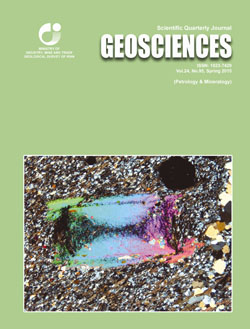Document Type : Original Research Paper
Authors
1 M.Sc. Student, Department of Geology, Faculy of Sciences, University of Birjand, Birjand, Iran
2 Associate Professor, Department of Geology, Faculy of Sciences, University of Birjand, Birjand, Iran
Abstract
The volcanic–sub volcanic activities in the Shah Soleyman area located in southwest of Birjand, east of Iran have cropped out as two categories of Pyroclastic – lava and sub volcanic rocks. The pyroclastic rocks are tuff, agglomerate with breccias and volcanic rocks are andesite, trachy- andesite and dacite. The porphyry and glomero- porphyric with micro granular to vitric groundmass are the main textures in these rocks. The porphyritic diorite is the unique sub volcanic unit in this area. Plagioclase, hornblende with oxidized rims, and biotite are the main phenocrysts. Sericitization, carbonatization and propylitic alterations are common in these rocks. Based on the geochemical study, these rocks have SiO2 in range of 56.8-61.9, high Al2O3 (16.5-18.1) and Sr (660-990), high Sr/Y (40.6-54.6), and low Y (16.1-19.7) that show adakites characteristic for the parent magmas. On the basis of geochemical characters, these rocks are high SiO2 adakites, which is considered to represent subducted basaltic slab melts that have reacted with peridotite during the ascent through mantle wedge. High ratio of LILE/HFSE, LREE/HREE and negative anomaly offor Nb and Ti show similarity with subduction- related magmatism. High Sr and negative anomalies of Ta, Nb, and Ti may be resulted from the lack of plagioclase and having iron and titanium oxides in the residual phase. The geochemical study showed that the source can be derived from subducted metamorphosed oceanic plate in east of Iran.

